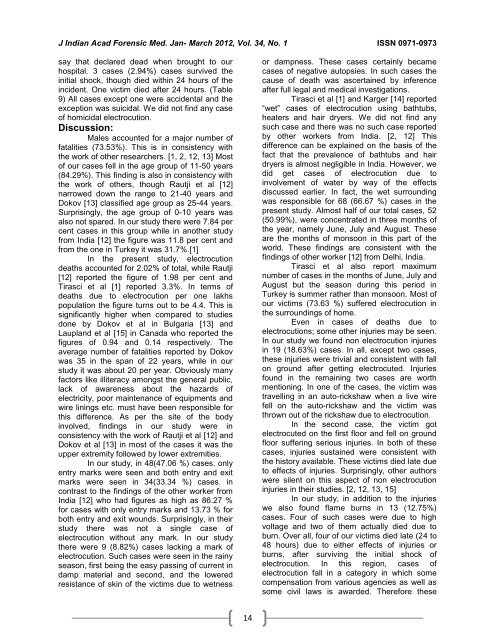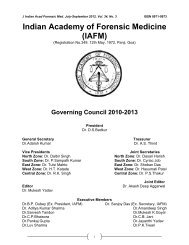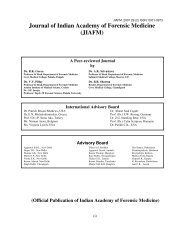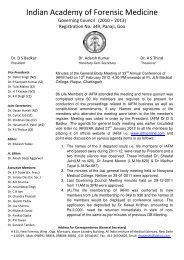Indian Academy of Forensic Medicine (IAFM) - Official website of IAFM
Indian Academy of Forensic Medicine (IAFM) - Official website of IAFM
Indian Academy of Forensic Medicine (IAFM) - Official website of IAFM
You also want an ePaper? Increase the reach of your titles
YUMPU automatically turns print PDFs into web optimized ePapers that Google loves.
J <strong>Indian</strong> Acad <strong>Forensic</strong> Med. Jan- March 2012, Vol. 34, No. 1 ISSN 0971-0973<br />
say that declared dead when brought to our<br />
hospital. 3 cases (2.94%) cases survived the<br />
initial shock, though died within 24 hours <strong>of</strong> the<br />
incident. One victim died after 24 hours. (Table<br />
9) All cases except one were accidental and the<br />
exception was suicidal. We did not find any case<br />
<strong>of</strong> homicidal electrocution.<br />
Discussion:<br />
Males accounted for a major number <strong>of</strong><br />
fatalities (73.53%). This is in consistency with<br />
the work <strong>of</strong> other researchers. [1, 2, 12, 13] Most<br />
<strong>of</strong> our cases fell in the age group <strong>of</strong> 11-50 years<br />
(84.29%). This finding is also in consistency with<br />
the work <strong>of</strong> others, though Rautji et al [12]<br />
narrowed down the range to 21-40 years and<br />
Dokov [13] classified age group as 25-44 years.<br />
Surprisingly, the age group <strong>of</strong> 0-10 years was<br />
also not spared. In our study there were 7.84 per<br />
cent cases in this group while in another study<br />
from India [12] the figure was 11.8 per cent and<br />
from the one in Turkey it was 31.7%.[1]<br />
In the present study, electrocution<br />
deaths accounted for 2.02% <strong>of</strong> total, while Rautji<br />
[12] reported the figure <strong>of</strong> 1.98 per cent and<br />
Tirasci et al [1] reported 3.3%. In terms <strong>of</strong><br />
deaths due to electrocution per one lakhs<br />
population the figure turns out to be 4.4. This is<br />
significantly higher when compared to studies<br />
done by Dokov et al in Bulgaria [13] and<br />
Laupland et al [15] in Canada who reported the<br />
figures <strong>of</strong> 0.94 and 0.14 respectively. The<br />
average number <strong>of</strong> fatalities reported by Dokov<br />
was 35 in the span <strong>of</strong> 22 years, while in our<br />
study it was about 20 per year. Obviously many<br />
factors like illiteracy amongst the general public,<br />
lack <strong>of</strong> awareness about the hazards <strong>of</strong><br />
electricity, poor maintenance <strong>of</strong> equipments and<br />
wire linings etc. must have been responsible for<br />
this difference. As per the site <strong>of</strong> the body<br />
involved, findings in our study were in<br />
consistency with the work <strong>of</strong> Rautji et al [12] and<br />
Dokov et al [13] in most <strong>of</strong> the cases it was the<br />
upper extremity followed by lower extremities.<br />
In our study, in 48(47.06 %) cases, only<br />
entry marks were seen and both entry and exit<br />
marks were seen in 34(33.34 %) cases. in<br />
contrast to the findings <strong>of</strong> the other worker from<br />
India [12] who had figures as high as 86.27 %<br />
for cases with only entry marks and 13.73 % for<br />
both entry and exit wounds. Surprisingly, in their<br />
study there was not a single case <strong>of</strong><br />
electrocution without any mark. In our study<br />
there were 9 (8.82%) cases lacking a mark <strong>of</strong><br />
electrocution. Such cases were seen in the rainy<br />
season, first being the easy passing <strong>of</strong> current in<br />
damp material and second, and the lowered<br />
resistance <strong>of</strong> skin <strong>of</strong> the victims due to wetness<br />
14<br />
or dampness. These cases certainly became<br />
cases <strong>of</strong> negative autopsies. In such cases the<br />
cause <strong>of</strong> death was ascertained by inference<br />
after full legal and medical investigations.<br />
Tirasci et al [1] and Karger [14] reported<br />
“wet” cases <strong>of</strong> electrocution using bathtubs,<br />
heaters and hair dryers. We did not find any<br />
such case and there was no such case reported<br />
by other workers from India. [2, 12] This<br />
difference can be explained on the basis <strong>of</strong> the<br />
fact that the prevalence <strong>of</strong> bathtubs and hair<br />
dryers is almost negligible in India. However, we<br />
did get cases <strong>of</strong> electrocution due to<br />
involvement <strong>of</strong> water by way <strong>of</strong> the effects<br />
discussed earlier. In fact, the wet surrounding<br />
was responsible for 68 (66.67 %) cases in the<br />
present study. Almost half <strong>of</strong> our total cases, 52<br />
(50.99%), were concentrated in three months <strong>of</strong><br />
the year, namely June, July and August. These<br />
are the months <strong>of</strong> monsoon in this part <strong>of</strong> the<br />
world. These findings are consistent with the<br />
findings <strong>of</strong> other worker [12] from Delhi, India.<br />
Tirasci et al also report maximum<br />
number <strong>of</strong> cases in the months <strong>of</strong> June, July and<br />
August but the season during this period in<br />
Turkey is summer rather than monsoon. Most <strong>of</strong><br />
our victims (73.63 %) suffered electrocution in<br />
the surroundings <strong>of</strong> home.<br />
Even in cases <strong>of</strong> deaths due to<br />
electrocutions; some other injuries may be seen.<br />
In our study we found non electrocution injuries<br />
in 19 (18.63%) cases. In all, except two cases,<br />
these injuries were trivial and consistent with fall<br />
on ground after getting electrocuted. Injuries<br />
found in the remaining two cases are worth<br />
mentioning. In one <strong>of</strong> the cases, the victim was<br />
travelling in an auto-rickshaw when a live wire<br />
fell on the auto-rickshaw and the victim was<br />
thrown out <strong>of</strong> the rickshaw due to electrocution.<br />
In the second case, the victim got<br />
electrocuted on the first floor and fell on ground<br />
floor suffering serious injuries. In both <strong>of</strong> these<br />
cases, injuries sustained were consistent with<br />
the history available. These victims died late due<br />
to effects <strong>of</strong> injuries. Surprisingly, other authors<br />
were silent on this aspect <strong>of</strong> non electrocution<br />
injuries in their studies. [2, 12, 13, 15]<br />
In our study, in addition to the injuries<br />
we also found flame burns in 13 (12.75%)<br />
cases. Four <strong>of</strong> such cases were due to high<br />
voltage and two <strong>of</strong> them actually died due to<br />
burn. Over all, four <strong>of</strong> our victims died late (24 to<br />
48 hours) due to either effects <strong>of</strong> injuries or<br />
burns, after surviving the initial shock <strong>of</strong><br />
electrocution. In this region, cases <strong>of</strong><br />
electrocution fall in a category in which some<br />
compensation from various agencies as well as<br />
some civil laws is awarded. Therefore these









